Q bond wheels for Outer race and Bore grinding of bearings
Carborundum Universal Limited
Dr. Xavier Kennedy, Sr.General Manager – Head of R&D, CUMI
Abstract:
Grinding is the most efficient way to obtain high accuracy and fine finish. Cylindrical grinding can be done internally and externally. Precision cylindrical surfaces have attracted considerable attention and interest from industry field and research community in recent years, due to the continual pursuit of perfect quality and high-performance products. Particularly in bearing industry, high-performance bearing often requires specific cylindrical surface properties such as high hardness, wear resistance, high strength, and toughness, because it is normally used in poor working environment. Besides, it is usually finished to a mirror-like surface for higher chemical stability.
Most of enterprises adopt bearing steel to manufacture bearing components. However, the bearing steel is known to be difficult to finish a mirror-like surface by grinding owing to its high hardness .Bearing raceway grinding process has a large influence on the work quality and the rotate accuracy of the bearings. Surface roughness and heat affected layer, which have a strong relationship with grinding process quality, are important factors relevant to the bearing raceway surface quality.
Outer Race grinding is a plunge kind of grinding. The grinding time and process quality consists of two aspects: one aspect is the microscopic topography of the surfaces, and the other aspect is the physical and mechanical properties of the surface heat-affected layer material.
Surface roughness can be used to represent the microscopic topography, which is an important factor of the surface quality. The microscopic topography is generated by a large amount of grains interacting with the work piece material in the grinding contact zone. The heat-affected layer is formed from high grinding temperature.
Another aspect of internal grinding is the operating convenience and cost. These factors shall be improved by enhancing the efficiency of the process. One of the key challenge in internal grinding is skip, i.e. number of components per dressing. Higher contact area of grinding impedes the accessibility of coolants to grinding zone. Most of the internal grinding process the skip improvement been considered as definite scope to increase the productivity, improve the Equipment availability and overall grinding cost.
Outer Race and bore grinding of bearings and challenges

Q bond wheels

CUMI has developed Q bond series of wheels for Outer race and bore grinding of bearings considering the dressing skip and burn free component as key focus areas. Reducing the dressing frequency has direct correlation with the structure, fracturing behaviour of abrasive and bond.
Q bond series grinding wheels has unique combination of surface modified abrasive grain with micro fracturing bond. Q bond is new generation product designed for maximum performance, cost saving and better grinding quality. Process Capability of Q bond used grinding process shown effective control on retaining the roundness of the components and significant reduction in heat burn.
Q bond series grinding wheels are extensively tested in Outer ring track and bore grinding (refer case studies). In both the applications dressing frequency is improved to 4 times. Significant drop in grinding power indicates the ease of grinding and less heat generation in the grinding process. In bore grinding 13-15% reduction on effective grinding time is been observed.

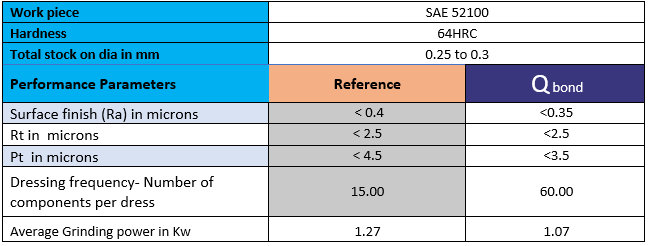
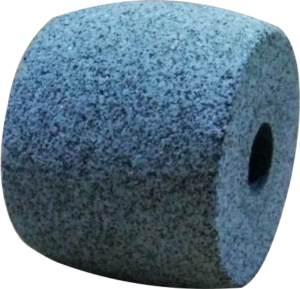
Dressing Frequency
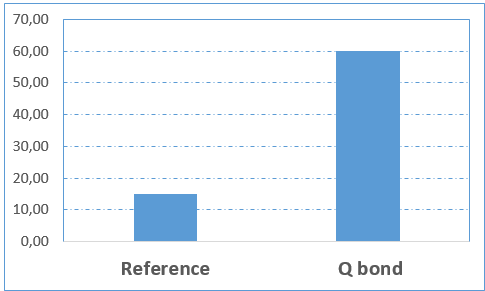

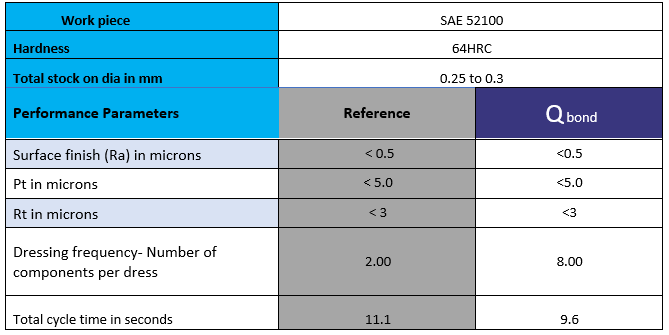
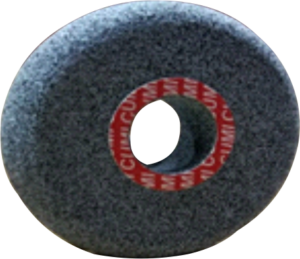
Dressing Frequency
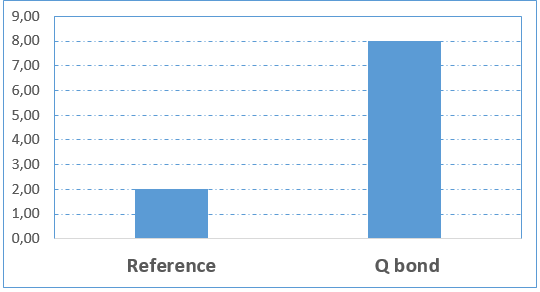
Conclusion:
Q bond wheels are designed to take high specific materials removal with minimum specific cutting energy. Improvement observed in dressing frequency and grinding time shall be optimised according to the bearing type, size and grinding parameters. Micro fracturing bond and surface modified abrasive feature is perfect blend to get maximize specific material removal with minimum cutting energy, Q bond deliver fastest and finest grinding in the industry.
References
- Stephenson DJ, Veselovac D, Manley S, Corbett J (2001) Ultra-precision grinding of hard steels. Precis Eng 25(4):336–345
- Pal B, Chattopadhyay AK, Chattopadhyay AB (2010) Development and performance evaluation of monolayer brazed cBN grinding wheel on bearing steel. Int J Adv Manuf Technol 48(9–12):935–944.
- Malkin S (1989) Grinding technology: theory and applications of machining with abrasives. Ellis Horwood, Chichester and Wiley, New York
